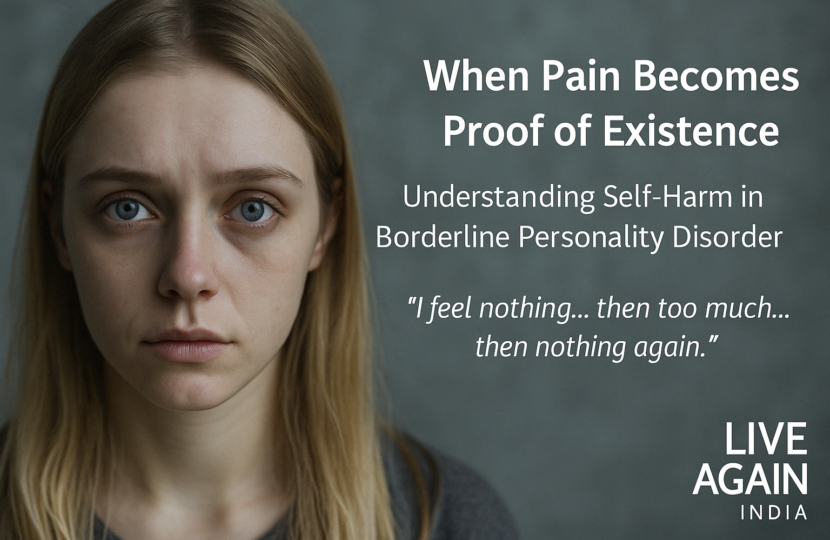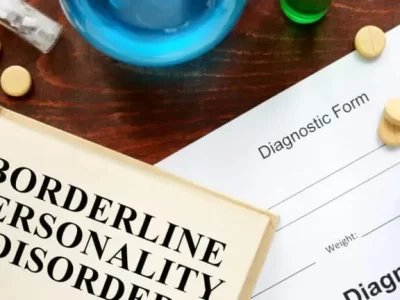Self-Harm in BPD: When Pain Becomes Proof of Existence: Self-harm is frequently misunderstood and stigmatized. Often dismissed as manipulation or impulsivity, it becomes a behavior that invites criticism instead of compassion. This oversimplification overlooks the psychological purpose self-harm serves in individuals with Borderline Personality Disorder (BPD). Rather than seeking attention, many are trying to reconnect with themselves – physically, emotionally, or symbolically. It is not the act alone, but the story behind it that must be understood. For these individuals, self-harm is less about harm and more about survival – an effort to re-anchor to a sense of reality when disconnection threatens their existence.
Emotional pain can be vague, abstract, and overwhelming. Physical pain, in contrast, is focused, clear, and immediate. In moments of dissociation, when individuals feel unreal or disconnected, self-harm becomes a visceral reminder that they still exist.
Rather than being attention-seeking, these behaviors are often kept private, hidden, or minimized. This reinforces a dangerous silence around the emotional realities of BPD, pushing individuals further into isolation. At its core, self-harm in BPD is not about dying – it is about trying to live with what feels unlivable.
Understanding the Emotional Landscape of BPD
Self-Harm in BPD: Emotional dysregulation is central to BPD. individuals experience emotions with overwhelming intensity. An offhand comment, a perceived rejection, or an unmet expectation can trigger a cascade of emotional reactivity.
Key features include:
- Emotional hypersensitivity to perceived social slights or threats is a defining feature of BPD. Individuals may interpret neutral or ambiguous remarks as rejection or criticism. Their nervous system is primed for hyper-alertness, often shaped by early relational trauma or neglect. Even minor social cues – like a delayed message or a shift in tone – can activate intense emotional responses. This hypersensitivity is not a flaw; it is the mind’s attempt to protect against emotional injury. But over time, it exhausts the person’s emotional resources and disrupts interpersonal stability.
- Difficulty returning to emotional baseline after a trigger is a hallmark of BPD emotional dysregulation. Once activated, the emotional response doesn’t just pass – it lingers, intensifies, and often spirals. individuals may find themselves caught in the aftermath of an emotional episode for hours or days, unable to self-soothe. This extended distress is not due to weakness, but due to disrupted neurological processing of emotion. The brain’s signaling systems remain in a heightened state of arousal, making even small subsequent stressors feel catastrophic. Over time, this erodes the person’s sense of emotional safety and predictability.
- A pervasive fear of abandonment is one of the most defining emotional experiences in BPD. Individuals often anticipate rejection or being left behind – even in safe or stable relationships. This fear may stem from early attachment disruptions or inconsistent caregiving during developmental years. As a result, individuals may engage in frantic efforts to avoid real or imagined abandonment, including clinging behavior or emotional outbursts. These reactions, though protective in nature, can ironically strain relationships and create the very distance they fear. The intensity of this fear often leads to chronic relational instability and emotional insecurity.
- Chronic feelings of emptiness are not momentary lapses in satisfaction – they are persistent and all-encompassing. individuals with BPD often describe a sense of internal void, as though nothing inside them feels stable, meaningful, or whole. This emptiness may be misinterpreted as boredom, but it is far deeper – a lack of self-cohesion or enduring identity. It can drive impulsive behaviors, as individuals attempt to “fill the void” through risky relationships, substances, or self-harm. The experience is not about wanting more from the world, but rather feeling as though one does not fully exist within it. Therapeutic work here involves helping individuals develop self-structure, meaning, and internal containment.
These intense emotional surges can lead to dissociation – a state where the person feels numb, detached, or disconnected from their body or environment. Dissociation in BPD isn’t rare; it is the mind’s defense against unbearable affect.
During these episodes, self-awareness fades. The person may feel like they are watching themselves from a distance, like a ghost in their own body. In this context, self-harm serves as a physical “anchor” back into their body and into reality.
The Paradox of Pain
Pain, in this context, is not always pathological – it is strategic. Self-inflicted pain becomes a grounding mechanism. In the same way someone might use cold water, deep breathing, or tactile objects to re-enter their body, some BPD individuals use pain.
“When I cut, I don’t want to die. I want to feel real.”
individuals may describe the pain as:
- A way to interrupt emotional overload is one of the primary functions individuals describe when self-harming. When their emotions reach an unbearable intensity, pain offers an immediate pause- an abrupt stop to the flood. It diverts attention from the internal chaos to a singular physical sensation, offering momentary clarity. The pain feels concrete in a world where everything else feels shapeless and overwhelming. This shift doesn’t solve the emotional conflict, but it creates a split-second of control. That interruption is often the only barrier standing between the individual and complete psychological collapse.
- A method of regaining control is a crucial psychological function of self-harm in BPD. When individuals feel powerless over their emotions, environment, or relationships, the act of self-harm restores a sense of agency. It becomes a controlled choice in the midst of perceived chaos. In a world where they often feel emotionally hijacked, the ability to inflict and tolerate pain gives them a brief moment of mastery. This behavior may not be rational, but it is intensely purposeful. The feeling of control, even if temporary, can be soothing in an otherwise uncontrollable reality.
- A ritual to organize internal chaos is how many individuals with BPD describe their self-harming behavior. In the face of overwhelming internal noise – racing thoughts, conflicting feelings, and emotional flashbacks – self-harm becomes a repetitive and predictable act. The ritual offers structure when everything else feels unstable or uncontained. It marks a beginning, middle, and end to emotional chaos, providing a symbolic way to express and manage pain. Even the tools, the preparation, and the aftermath can provide a false sense of order. While maladaptive, the behavior offers a temporary illusion of control and coherence.
- An outlet for self-directed rage or guilt can manifest when emotional pain turns inward. Many individuals with BPD carry intense feelings of shame, inadequacy, or unresolved anger that they do not know how to process or express outwardly. When these emotions reach a breaking point, self-harm becomes a form of punishment or catharsis. It provides a temporary release valve for internalized blame or suppressed anger. In some cases, it offers a sense of relief from the burden of unspoken guilt or rage. Though maladaptive, this expression feels validating in the moment – translating invisible suffering into something tangible and real.
Ironically, the act of hurting the body often provides emotional relief. In that moment, the pain becomes the proof. It says, “I am here. I am not invisible. I exist.” This paradox is what makes treatment so complex: the very thing causing damage is also serving a stabilizing purpose.
Neurobiological Insights
Self-harm is not just behavioral or emotional – it is neurochemical. Scientific research shows that self-injury leads to the release of endorphins and dopamine in the brain. These are the same neurotransmitters associated with pleasure, relief, and euphoria.
This leads to a powerful neurological loop:
- Emotional distress escalates when overwhelming emotions become unmanageable and flood the individual’s system. It may begin with a perceived slight, rejection, or internal shame trigger. These emotions build rapidly and can feel physically intolerable. The distress is not only psychological but somatic – racing heart, shallow breath, or physical agitation. individuals often describe this moment as a loss of control or emotional drowning. Without coping tools, this escalation becomes the gateway to self-harming behaviors.
- Self-harm is enacted as an immediate, intentional response to the emotional flood. The act is often premeditated or ritualized, offering a sense of relief even before the pain begins. For many, it’s not impulsivity – it’s a well-practiced, deeply wired mechanism of release. The moment of cutting, burning, or hitting serves as a full-body reset. This act allows a shift in focus from chaos to sensation, from panic to precision. Though it appears harmful, it is rooted in the desperate need for grounding.
- Brain releases endorphins and dopamine as part of the body’s natural response to acute physical stimulation. These chemicals act as natural opioids, producing a calming or euphoric effect. This biological response temporarily dulls both physical and emotional pain. For the individual, this moment provides a deceptive sense of peace or clarity, reinforcing the behavior. The relief experienced strengthens the psychological bond between self-harm and emotional regulation. Over time, this reinforces a powerful behavioral cycle that becomes harder to interrupt without therapeutic intervention.
- Emotional distress is reduced as the body responds to the neurochemical surge triggered by self-harm. This reduction isn’t merely felt emotionally – it is experienced physically as well. Breathing slows, tension diminishes, and the inner chaos momentarily quiets. For the individual, it feels like a temporary sanctuary from overwhelming affect. However, this soothing effect is fleeting and often followed by emotional consequences. The cycle restarts when distress builds again, reinforcing dependence on the behavior.
- Brain reinforces the behavior as effective by linking the relief it brings with the act itself. Each time self-harm leads to a decrease in emotional pain, the brain learns to associate the behavior with emotional regulation. This reinforcement makes the act feel increasingly necessary in moments of distress. The repetition of this cycle strengthens neural pathways that favor self-harm as a coping mechanism. Over time, it becomes the brain’s default response to psychological overwhelm.
Over time, this becomes a conditioned coping mechanism, similar to addiction. The body learns: “Pain stops panic.” Additionally, many BPD individuals have disrupted serotonergic systems, making them more vulnerable to mood instability and impulsivity. The pain isn’t addictive in a recreational sense – it becomes functional.
How Therapist Can Help You
A therapist provides emotional safety, trauma containment, cognitive restructuring, and affect regulation support. In the case of self-harm and BPD, therapy is not just about understanding behavior – it’s about holding the emotional storm until it passes. At L@A, our clinicians form real relationships with clients – not just protocols.
The goal is not control – it is reconnection.
Therapy is not just about eliminating behaviors – it’s about understanding what those behaviors are replacing.
Welcome Back to Live Again
You are not broken.
You are not alone.
Healing is possible – not in silence, but in supported space.
Welcome back to Live Again.



